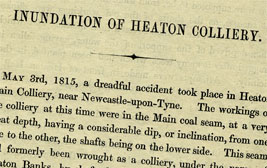An Inundation of Heaton Colliery

Extract from report
Exertions were immediately made to reach the spot where the men were supposed to be, from some other workings, but without success,...
By this catastrophe seventy-five persons (forty-one men and thirty-four boys) lost their lives, together with the whole stock of horses, which were down at the time.
From various difficulties, the bodies of these unfortunate men were not arrived at until upwards of nine months from the time of the accident...
On the 6th of January, 1816, the first human body of the sufferers was brought to bank, in a state of great decay; but ascertained by the neckcloth to be that of William Scott,...there were ten human bodies, and the carcases of two horses found. The water had never risen so high as the above workings...
Memoir of William Thew
One of the sufferers in the inundation of the Heaton Colliery, 1815.
Willam Thew was the second son of John and Elizabeth Thew, and was seventeen years of age at the time of the catastrophe. His father, and an elder brother, aged twenty, named George, perished with him.
To contemplate seventy-five human beings all at once incarcerated in a living tomb, with the appalling prospect of a lingering, though certain death. They had not died from hunger, as they had killed one of the horses and had cut slices off its hind quarter, some of which were found in the caps and wallets of the men, unconsumed. They had likewise an abundant supply of spring water. The exhaustion of the atmospheric air by the influx of water bringing with it foul air, was no doubt the cause of death, probably in a day or two at the most...

"Fret not, dear mother, for we were singing while we had time, and praising God. Mother, follow God more than ever I did:" and then on the other side, which, it is supposed, must have been dictated by his father, as it bears his signature, though he could not write: "If Johnny is saved, be a good lad to God, and thy mother" – John Thew
